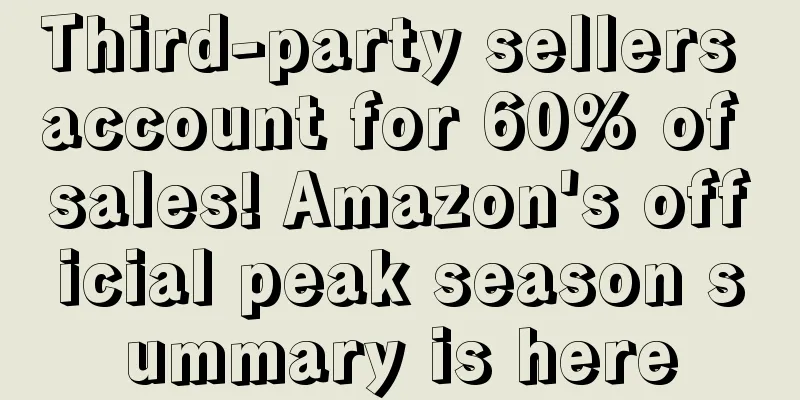Third-party sellers account for 60% of sales! Amazon's official peak season summary is here

|
Last weekend, Amazon released an overall summary report for this year's peak season, stating that this year was Amazon's best peak season in 20 years. Amazon officials said that during this year's peak season, more than 60% of sales came from third-party sellers on the platform, a higher proportion than last year's 50%. Most of them came from small and medium-sized sellers. In categories including home, beauty, kitchen, toys and clothing, consumers prefer to choose new brands and new products with more competitive prices. In some officially announced new brand sales cases, 3P sellers' sales during the peak season in the fourth quarter increased by about two to four times, with the highest growth rate for a board game seller even exceeding 800%. The official will certainly pick out the good things in the report, so let's analyze it from some points other than the content of the report. First of all, the release time of Amazon's report is quite intriguing. Generally speaking, Amazon releases the peak season overview report about a week after the end of Cyber Monday, but this year it took nearly a month to come up with a report without any specific data. You should know that the peak season overview reports of last year and the year before last both had specific category performance and partial data. The 2020 report even wrote about the specific sales of third-party sellers during Black Friday Cyber Monday. In contrast, this year's report only has one overall data: "third-party sellers account for more than 60% of sales", and then only some seller cases, and other overall data are kept silent. Only when Amazon's Q4 financial report comes out can we get a glimpse of how Amazon really performed during this peak season. Of course, this report is not meaningless. At least we know one thing: Amazon's self-operated business is indeed giving up its market share step by step. On the one hand, it has an anti-monopoly effect, and on the other hand, there are too many sellers for the official self-operated business to handle. However, the concession of self-operation will definitely lead to Amazon increasing its efforts to cut leeks in other aspects. It is foreseeable that the price of Amazon's third-party seller services will inevitably rise. During the peak season last year, some media reported that Amazon received at least $121 billion in monthly revenue from third-party sellers in a year through various forms of fees such as platform monthly rent, commissions, FBA fees and advertising fees. This figure accounts for about 34% of the sellers' total sales! This is equivalent to paying Amazon $34 for every $100 product sold by the seller. This year, Amazon has charged in various ways under various pretexts, such as fuel and inflation surcharges in the middle of the year, and peak season delivery surcharges at the end of the year. So this year, the proportion will only be higher. Amazon is gradually changing from self-operation to a pure platform to earn commissions. Presumably this is also one of the official means to avoid the future split of the business. |
<<: The real trump card: the supply chain advantage brought by China's industrial clusters
>>: Amazon's biggest layoffs in history! Why did its stock price rise instead of falling?
Recommend
Mexico's new policy: Amazon and other foreign e-commerce platforms will impose a 16% VAT starting next year
It is learned that recently, the Mexican National ...
Things to do with off-site discount code stacking~
Will coupons/ promotions/ deals stack? The answer ...
How to prevent traffic loss during peak season? Methods used by Amazon sellers!
text The peak season of Member Day is here. Are yo...
What is Italian VAT Registration? Italian VAT Registration Review
VAT is the abbreviation of Value Added Tax, which ...
What is Bol.com? Bol.com Review
Bol.com is the largest e-commerce platform in the ...
What is Xinhao? Xinhao Review
Xinhao (Shanghai) Freight Forwarding Co., Ltd. is ...
What is PriceFox? PriceFox Review
Price-Fox aims to help sellers automatically monit...
2022 Amazon Operational Thinking Full Process
As a qualified Amazon operator, you must have a c...
Official announcement: Alibaba acquires Kaola for $2 billion and leads investment in NetEase Cloud Music
On September 6, Beijing time, NetEase and Alibaba ...
Amazon’s best-selling product selection formula can be applied directly!
Competition in cross-border e-commerce is becoming...
What is HyperSuggest? HyperSuggest Review
HyperSuggest is a keyword tool that provides thous...
50,000 accounts blocked, sellers may sue Amazon! Another big seller has to clear out inventory?
▲ Video account attention: cross-border navigation...
What is River Cleaner? River Cleaner Review
River Cleaner is a keyword research and optimizati...
How to get more natural traffic distribution from Amazon links? What kind of results are considered successful promotions?
Qiaotuntun My C position As the title says, most A...
What is WeMakePrice? WeMakePrice Review
WeMakePrice is a Korean e-commerce website special...









